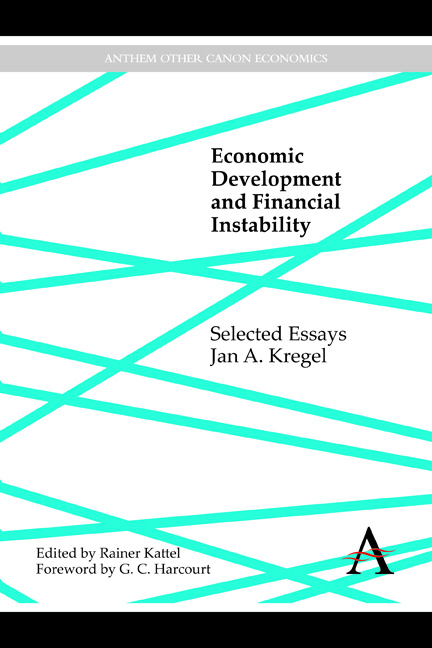Book contents
- Frontmatter
- Contents
- Foreword
- Publication History
- I Theoretical Discussions
- II Finance for Development
- III The Crisis in the US and the EU
- 16 Alternative Economic Analyses of German Monetary and Economic Unification: Monetarist and Post Keynesian
- 17 Currency Stabilization through Full Employment: Can EMU Combine Price Stability with Employment and Income Growth?
- 18 Minsky's “Cushions of Safety,” Systemic Risk and the Crisis in the Subprime Mortgage Market
- 19 Why Don't the Bailouts Work? Design of a New Financial System versus a Return to Normalcy
- 20 Is This the Minsky Moment for Reform of Financial Regulation?
- 21 Debtors' Crisis or Creditors' Crisis? Who Pays for the European Sovereign and Subprime Mortgage Losses?
- 22 Six Lessons from the Euro Crisis
- 23 Minsky and the Narrow Banking Proposal: No Solution for Financial Reform
- Index
22 - Six Lessons from the Euro Crisis
from III - The Crisis in the US and the EU
Published online by Cambridge University Press: 05 November 2014
- Frontmatter
- Contents
- Foreword
- Publication History
- I Theoretical Discussions
- II Finance for Development
- III The Crisis in the US and the EU
- 16 Alternative Economic Analyses of German Monetary and Economic Unification: Monetarist and Post Keynesian
- 17 Currency Stabilization through Full Employment: Can EMU Combine Price Stability with Employment and Income Growth?
- 18 Minsky's “Cushions of Safety,” Systemic Risk and the Crisis in the Subprime Mortgage Market
- 19 Why Don't the Bailouts Work? Design of a New Financial System versus a Return to Normalcy
- 20 Is This the Minsky Moment for Reform of Financial Regulation?
- 21 Debtors' Crisis or Creditors' Crisis? Who Pays for the European Sovereign and Subprime Mortgage Losses?
- 22 Six Lessons from the Euro Crisis
- 23 Minsky and the Narrow Banking Proposal: No Solution for Financial Reform
- Index
Summary
1. Currency Zones Don't Solve the Problem of Payments Imbalances
The problems that are now being faced by the eurozone are not new; we have been here before. Remember the global imbalances and currency turbulence that produced the 1985 Plaza Accord, and then the meeting at the Louvre, and, finally, the freefall collapse of the dollar? At that time, many economists proposed that the exchange rate instability produced by global payments imbalances could be resolved by dividing the world into independent, unified currency zones dominated by the dollar, deutsche mark (DM), and yen. However, the introduction of the euro to create an ersatz DM zone does not seem to have produced the stability that the proponents of such a system had envisaged, even within the eurozone. Indeed, the attempts to manage the dollar-DM-yen exchange rates in the Plaza and Louvre Agreements eventually generated an equity and real estate bubble in Japan whose collapse ushered in decades of stagnation and eliminated any possibility for the creation of a yen zone in Asia. As is now recognized, even within the DM zone, the imbalances that had plagued the European Economic Community (EEC) were not eliminated; instead, they were exacerbated by the introduction of the single currency.
2. The “Structuralists” Got It Wrong
Recall the debates between the “economists” and the “structuralists” on the appropriate means of transforming the EEC into a unified “single market” economic zone.
- Type
- Chapter
- Information
- Economic Development and Financial InstabilitySelected Essays, pp. 337 - 342Publisher: Anthem PressPrint publication year: 2014

